Guitar Lessons that work!

Welcome to Guitar Secrets
Lead Guitar Made Easy
Guitar Chord Fill and the Pentatonic scale
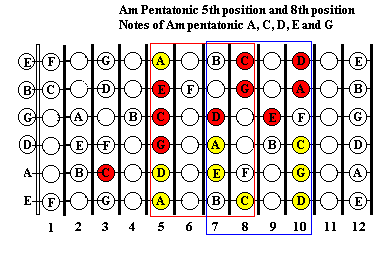 |
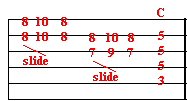
There are many, many possibilities like the one above. Work with this scale and come up with your own. We will continue to work on this technique, but until then, experiment and you will grow. |
You may be saying, hey I know these chords. Yes, you may know these chords and you might even use them everyday in your playing. But do you know where they come from? I would have to say the majority of all questions I’ve received in the years I’ve been teaching or playing would have to be, where do I play lead, or what chords do I use? I don’t want to overwhelm you on chord theory here in this chapter, but we need to look at some very interesting things going on here. Look at the chords below.
Look at each chord very closely. Look at the Am7 chord. You should notice that the notes of this chord are, A, C, E and G. You should also know that the Am7 chord below is a Root 6 bar chord. This means that the chord is determined by the note on the 6th or Low E string. The Dm 7 and Em7 are Root 5 bar chords. This means that these chords are determined by the note on the A string. These are movable bar chords which mean you can move each of these chords all over the fret-board.
Look at the Dm7 and see that it has the same fingering as the Em7. The only difference is the Dm7 is played at the 5th fret and the Em7 is played at the 7th fret. This is because the D note is at the 5th fret A string for the Dm7 and the E note is at the 7th fret A string for the Em7. The 5th fret D note highlighted in Blue would be the root note. The E note at the 7th fret highlighted in red would be the root for for the Em7 chord. When you strum this chord, you can start with that root note.[pms-restrict subscription_plans=”1778,1808,3203″]
 |
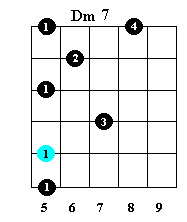 |
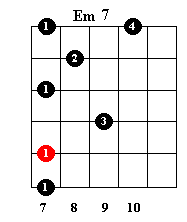 |
| Am7 is made up of the 1, b3, 5 and b7 A, C, E and G |
Dm7 is made up of the D, F, A and C |
Em7 is made up of the E, G, B and D |
1, 2, b3, 4, 5, b6, b7
Each of the guitar chords illustrated above, can be found in the key of C major. Each chord is formed out of the minor scale using the formula above.
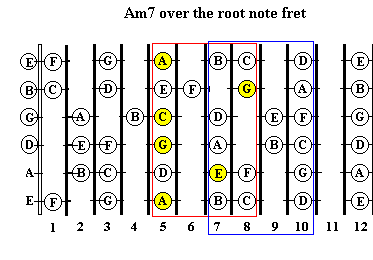 |
 |
Look at the image above and notice that it is right out of the key of C major. Notice all of the notes of the Am7 chord and begin to visualize playing these notes in your lead guitar work. Lay these chords down on a recorder and play these notes as arpeggios. Pick each note one note at a time. Strum the Am7 chord and rock out. Begin to see how each chord if formed for each scale.
Assignments:
- Use the blank illustrations to fill in the notes of the Am, Am7, Dm, Dm7, Em and Em7 chords.
- Use the blank tablature sheets to fill in the chords in arpeggio form. Play each chord above as arpeggios.
If you use the blank forms and fill them in, you will get to learn the guitar fret-board inside and out. Use all of the illustrations and experiment. Use the blank illustration of the fret-board and fill in all of the notes of the C chord up and down the fret board. Use the blank illustration and fill in all the notes of the Dm chord. You will see where each note is positioned. You will begin to improvise over these different positions and open up endless possibilities and new sounds.
Good Luck,
From the Jam Room
Save
Save
Save
Save
Save
Save
Save
Save

